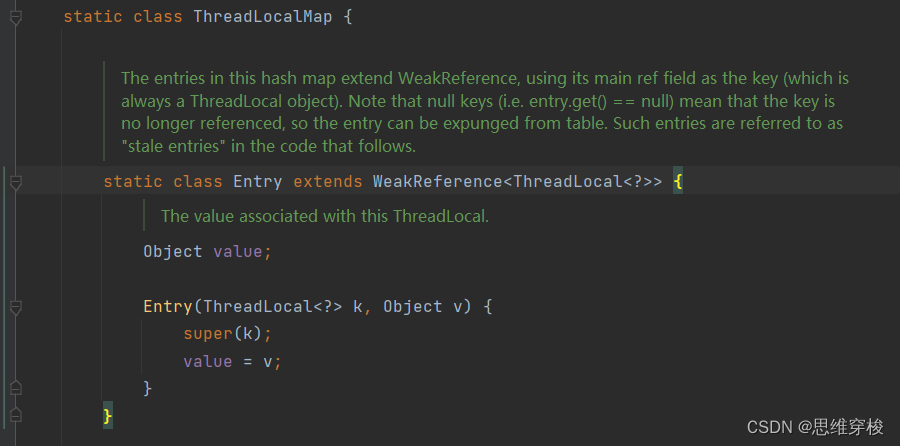作用及注意事项
ThreadLocal的主要作用是提供线程内部的局部变量。这种变量在多线程环境下访问时(通过get或set方法访问),能保证各个线程里的变量相对独立于其他线程内的变量。每个线程通过其内部的ThreadLocalMap持有该线程本地实例的引用,因此ThreadLocal确保线程内的局部变量对其他线程是不可见的,实现了线程间的数据隔离。
需要注意的是,ThreadLocal并不是为了解决多线程程序的并发问题或共享问题而设计的,而是提供了一种在线程内部存储和获取数据的方式,使得线程内的数据对其他线程不可见,从而实现线程间的数据隔离。
此外,使用ThreadLocal时需要注意内存泄漏的问题,特别是在使用了线程池等场景时,由于线程是长生命周期的,如果每个线程内部都通过ThreadLocal持有了大对象,那么可能会导致内存溢出。因此,在使用完ThreadLocal后,最好手动调用其remove()方法,以显式删除线程局部变量,防止内存泄漏。
代码分析
使用代码演示功能:
package com.dream.test.threadLocal;
import java.text.SimpleDateFormat;
import java.util.Random;
public class ThreadLocalExample implements Runnable{
private static final ThreadLocal<SimpleDateFormat>
// threadLocal = ThreadLocal.withInitial(()-> new SimpleDateFormat("yyyy-MM-dd"));
threadLocalNew = new ThreadLocal<>();
private static final ThreadLocal<SimpleDateFormat>
threadLocalInit = ThreadLocal.withInitial(()-> new SimpleDateFormat("yyyy-MM-dd"));
public static void main(String[] args) throws InterruptedException {
ThreadLocalExample example = new ThreadLocalExample();
for (int i = 0; i < 10; i++) {
Thread thread = new Thread(example, "thread:" + i);
Thread.sleep(new Random().nextInt(100));
thread.start();
}
}
@Override
public void run() {
System.out.println("Thread Name= "+Thread.currentThread().getName()+" threadLocalNew 方式:"+ (threadLocalNew.get() == null ? "null" : threadLocalNew.get().toPattern()));
System.out.println("Thread Name= "+Thread.currentThread().getName()+" threadLocalInit 方式: "+threadLocalInit.get().toPattern());
try {
Thread.sleep(new Random().nextInt(1000));
threadLocalNew.set(new SimpleDateFormat());
threadLocalInit.set(new SimpleDateFormat());
System.out.println("Thread Name= "+Thread.currentThread().getName()+" reset threadLocalNew 方式:"+ (threadLocalNew.get() == null ? "null" : threadLocalNew.get().toPattern()));
System.out.println("Thread Name= "+Thread.currentThread().getName()+" reset threadLocalInit 方式: "+threadLocalInit.get().toPattern());
} catch (InterruptedException e) {
e.printStackTrace();
} finally {
// 清除当前线程的ThreadLocalMap中ThreadLocal的值
threadLocalNew.remove();
threadLocalInit.remove();
// 重新获取查看是否已经删除
System.out.println("Thread Name= "+Thread.currentThread().getName()+" remove threadLocalNew 方式:"+ (threadLocalNew.get() == null ? "null" : threadLocalNew.get().toPattern()));
System.out.println("Thread Name= "+Thread.currentThread().getName()+" remove threadLocalInit 方式: "+threadLocalInit.get().toPattern());
}
}
}
程序运行结果:

通过运行结果,我们发现通过ThreadLocal.withInitial()方法创建的ThreadLocal对象remove没有清空值。这个问题通过ThreadLocal的get()来分析,我们先看set()方法。
ThreadLocal类set方法:
public void set(T value) {
Thread t = Thread.currentThread();
ThreadLocalMap map = getMap(t);
if (map != null)
map.set(this, value);
else
createMap(t, value);
}
ThreadLocalMap getMap(Thread t) {
return t.threadLocals;
}
void createMap(Thread t, T firstValue) {
t.threadLocals = new ThreadLocalMap(this, firstValue);
}
set方法作用是将值塞到当前线程Thead的TreadLocalMap中,其中key是TreadLocal类的弱引用。
TreadLocal的get()方法:
public T get() {
Thread t = Thread.currentThread();
ThreadLocalMap map = getMap(t);
if (map != null) {
ThreadLocalMap.Entry e = map.getEntry(this);
if (e != null) {
@SuppressWarnings("unchecked")
T result = (T)e.value;
return result;
}
}
return setInitialValue();
}
private T setInitialValue() {
T value = initialValue();
Thread t = Thread.currentThread();
ThreadLocalMap map = getMap(t);
if (map != null)
map.set(this, value);
else
createMap(t, value);
return value;
}
protected T initialValue() {
return null;
}
static final class SuppliedThreadLocal<T> extends ThreadLocal<T> {
private final Supplier<? extends T> supplier;
SuppliedThreadLocal(Supplier<? extends T> supplier) {
this.supplier = Objects.requireNonNull(supplier);
}
@Override
protected T initialValue() {
return supplier.get();
}
}
get方法是从当前Thread的ThreadLocalMap中取值。
remove方法打印不一致问题,是因为remove后 ThreadLocalMap.Entry e 是null,程序会运行
setInitialValue方法,
这个方法会将 initialValue()方法的值重新塞进ThreadLocalMap中。通过new ThreadLocal<>()创建的TheadLocal对象运行ThreadLocal的initialValue()方法,返回null; 通过 ThreadLocal.withInitial()创建的对象运行的是 内部类SuppliedThreadLocal的initialValue()方法,返回的是初始值。






















 424
424











 被折叠的 条评论
为什么被折叠?
被折叠的 条评论
为什么被折叠?








